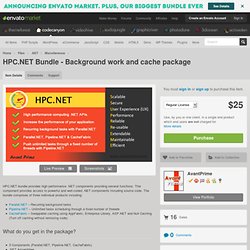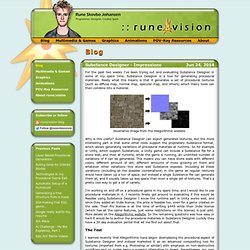

.NET - HPC.NET Bundle - Background work and cache package. HPC.NET bundle provides high performance .NET components providing several functions.

This component provides access to powerful and well-coded .NET components including source code. The bundle comprises of three individual products including: Parallel.NET – Recurring background tasks Pipeline.NET – Unlimited tasks scheduling through a fixed number of threads CacheFabric – Swappable caching using AppFabric, Enterprise Library, ASP.NET and Null Caching (Turn off caching without removing code) What do you get in the package? 3 Components (Parallel.NET, Pipeline.NET, CacheFabric) .NET Assemblies Debug files (PDB) Xml comments (Intellisense) Usage documentation API Documentation Demo applications C# & VB.NET Source Code Support Contact us at support.avantprime.com for help with any questions and issues you may have. Updates: Substance Designer #1 - Overview of a Substance. Substance Designer : FX maps? I've watched the new tutorials posted, and read the documentation on FX-maps.

Though It really..barely..even touches the depth of them? I am just extremely confused on how to use these FX maps, and they're the base of creating some great substances. I understand a lot of it has to do with creating dynamic complex functions? I can not seem to find a lot of documentation on understanding what each does and when/how you use it. Which ones act as inputs, outputs... I do not know what to ask to help me learn it, I just need someone to direct me..
Also, while it says it accepts greyscale, I always have to have it converted to a color because otherwise it is completely transparent on my FX. I am so lost right now its almost painful. Substance Designer on Pinterest. SD Tutorials - Atomic Nodes. Substance Designer - Master Thread. Ok so, this is really rough, but with time, blends, and gradients this could start looking something like fur or grass or what have you.

So under Generators - Patterns - grab the Shape node and drag that out into your Substance editor. For this test I used the pyramid shape, but I've messed around with others and gotten interesting results. Then under Noises grab the Splatter node and run the Shape node through the Splatter. Changing the parameters of the splatter node ended up producing these two very different results. To change the length of the shape that you input into the Splatter node, adjust the Pattern Size Width and Height. The node on the top tiles more than the node on the bottom which is caused by increasing the Grid Number. SO you can do a lot with the splatter and shape nodes, its just getting them to work efficiently that is the trick.
I hope that helped or was useful in some way. Allegorithmic - YouTube. Procedural, multi-use rock Substance. Choosing Output Maps & Shaders: Substance Designer & Unity. Substance Designer User's Guide - Substance Designer 4.4 - Allegorithmic Documentation. Cartoony/HandPainted Substance Experiment. New FX-Maps Tutorial.
Blog: Substance Designer - Impressions. For the past two weeks I've been trying out and evaluating Substance Designer in some of my spare time.

Substance Designer is a tool for generating procedural materials. Really what this means is that it generates a set of procedural textures (such as diffuse map, normal map, specular map, and others) which many tools can then combine into a material. Illustrative image from the Allegorithmic website. Why is this useful? Substance Designer can export generated textures, but the more interesting part is that some other tools support the proprietary Substance format, which allows generating variations of procedural materials at runtime.
I'm working on and off on a procedural game in my spare time, and I would like to use procedural materials in it. The Test I learned recently that Allegorithmic have begun downplaying the procedural aspect of Substance Designer and instead marketed it as an advanced compositing tool for textures (imported from e.g. The Main Graph Function Graphs Limitations.